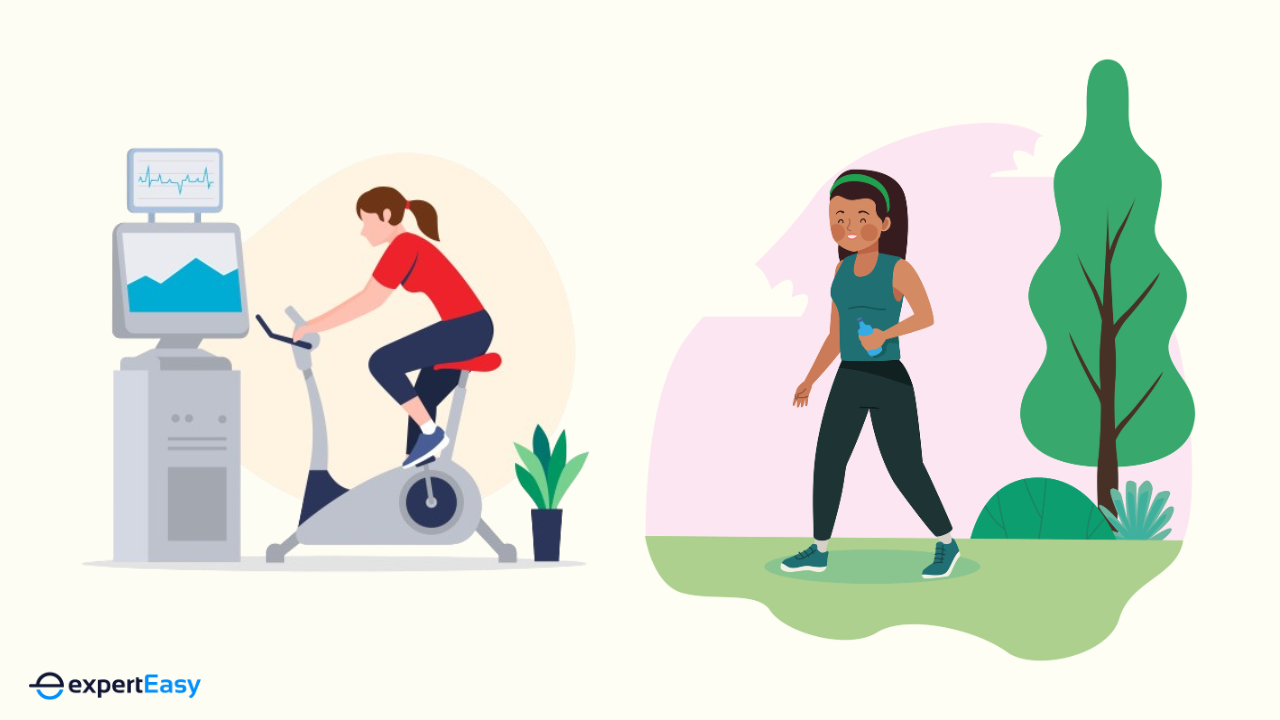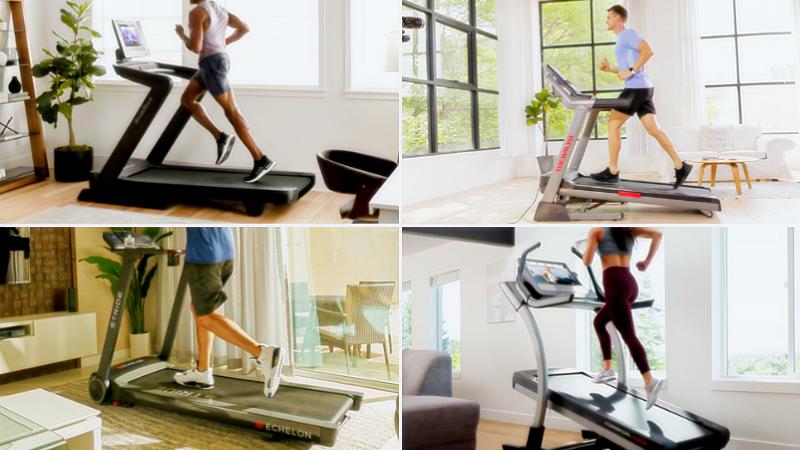The best workout to reach your health goals is always a topic for discussion. What equipment is appropriate? Should you work out at home or visit the gym? Do you need a trainer, or you're best suited to working alone?
To decide which is the ideal workout, your personal preferences, fitness objectives, and medical conditions all play a crucial role.
In this guide, I will examine the benefits and differences between stationary bikes and walking.
Stationary Bikes vs. Walking: Health Benefits

First, let's examine the health benefits of both workouts in order to assist you in selecting the ideal workout for you.
Health Benefits of Stationary Bikes
Here are the health benefits of using a stationary bike:
- Low-impact workout: Stationary bikes offer a low-impact workout, which is helpful if you are recovering from an injury or have joint problems. Compared to other forms of exercise, cycling has less of an impact on joints, which lowers the risk of injury.
- Cardiovascular health: Cycling enhances cardiovascular fitness. Thus, using stationary bikes regularly improves your blood pressure, heart health, and general endurance.
- Muscular strength: Riding a stationary bike helps you work out your quadriceps, hamstrings, and glutes.
Health Benefits of Walking
Walking has its own health benefits, which include:
- Low-impact workout: Walking is also a low-impact workout. Like exercise bikes, it is an excellent option if you suffer joint problems like osteoarthritis in the knee.
- Cardiovascular health: You can also enhance your cardiovascular health by walking on a regular basis. The American Heart Association's journal proves that brisk walking reduces the risk of heart disease by an equivalent amount to running.
- Mental well-being: The beneficial effects of walking on mental health are one feature that distinguishes it from exercise bikes. It lowers your levels of stress, anxiety, and depression.
- Weight loss: Walking can help you lose weight even though it doesn't burn as many calories as intense exercise on a stationary bike. Research shows that walking regularly helps lower body fat.

Stationary Bike vs. Walking: Which Wins?

Both stationary biking and walking are excellent forms of cardiovascular exercise. The choice between them depends on personal preferences, fitness goals, health conditions, and time constraints. Let's take a closer look at the differences between stationary biking and walking.
Safety and the Avoidance of Injuries
Stationary exercise bikes reduce your risk of getting hurt, especially when it comes to avoiding falls, traffic hazards, and inclement weather. They are kinder also to your joints, which is advantageous for people who have joint problems.
On the other hand, there are a number of hazards that come with walking outside, like uneven ground and inclement weather, which can result in injuries. Be cautious of surfaces like cracked or damaged concrete, snow or ice, and holes in the ground.
Time Saving and Convenience
Stationary bikes allow you to adjust the intensity of your workouts, which enables them to perform high-intensity interval training (HIIT) and burn more calories in less time. If you're a busy person or only have limited time to exercise, stationary exercise bikes are a time-efficient option.
Walking is a flexible exercise that you can perform practically anywhere, from a park walk to a mountain hike. Compared to stationary bikes, however, the latter offers a reliable indoor workout option. Of course, you could walk at home, but that often lacks the intensity and variety that a stationary bike can provide.
The Cost and Equipment
Buying a stationary bike is often a one-time payment, and there are several models to choose from, including spin bikes, upright exercise bikes, and recumbent exercise bikes. Thus, you're likely to find one that fits your budget needs and fitness goals.
All you need for walking is a decent pair of shoes and clothing appropriate for the weather. This makes it a financially advantageous choice if you are on a tight budget or prefer to avoid purchasing exercise equipment.
Flexibility and Pleasure
Many stationary bikes have numerous routines to choose from, including HIIT and steady-state cardio, so you can keep your workouts exciting and varied. There is also a range of online resources and stationary bike workouts that are easily accessible to keep things interesting.
Walking is a rejuvenating and mentally stimulating activity that enables you to experience nature, discover new paths, and enjoy the outdoors. If you enjoy working out in a social setting, joining a walking group or going for a stroll with friends adds a social component.
Stationary Bike or Walking? Making a Decision

Having discussed the advantages, variations, and factors to consider, my advice is to pick the exercise that best meets your needs and preferences.
Tip #1 - Objectives for Personal Fitness
Stationary bikes are a great choice if you want to work on your quadriceps, hamstrings, and glutes, among other lower-body muscle groups. Conversely, walking works more muscles throughout the entire body and uses less of your upper and core.
For weight loss, stationary bikes are more beneficial for higher-intensity workouts. Nevertheless, walking can still be a valuable strategy for managing weight, particularly when paired with a balanced diet and way of life.
Tip #2 - Limitations and Health Conditions
Compared to walking, stationary bikes provide a low-impact workout that is easier on your joints. They are, therefore, a fantastic choice for those with joint issues or restricted movement.
Walking and exercise bikes can also help strengthen your heart. Before starting any exercise program, especially if you have a heart condition, you should consult your doctor. They will help you decide on the safest and ideal form of exercise for your particular circumstances.
Tip #3 - Drive and Dedication
It can be challenging to maintain your motivation on a stationary bike if the workout gets boring. In this case, I recommend experimenting with different stationary bike routines or enrolling in online classes.
Walking, however, is rarely dull. It provides fresh air, a change of scenery, and social interaction—all of which can boost your motivation. You can also use fitness trackers or apps to maintain interest in your walking routine by creating objectives and monitoring your development.
How to Incorporate Stationary Bikes in Your Daily Routine?
Incorporating stationary bikes into your daily routine can be a fantastic way to enhance your cardiovascular fitness, burn calories, and promote overall well-being. Here are some practical tips to do this:
- Suggested frequency of exercise: Aim for 150 minutes of moderate-intensity aerobic activity (like stationary biking) or at least 75 minutes of vigorous-intensity aerobic activity each week. This can be divided into shorter weekly sessions, like five days a week of 30 minutes each.
- Creating a home gym: Fitting workouts into your hectic schedule can be more accessible by purchasing a high-quality stationary bike. Depending on your preferences and objectives, you have a variety of best stationary bikes to choose from, including spin bikes, upright exercise bikes, and recumbent exercise bikes.
- Classes and Internet resources: Consider enrolling in online spin bike sessions or local exercise bike classes to stay motivated and keep things interesting. These resources can provide you with structured workouts and a supportive community to help you stay committed.

How to Incorporate Walking in Your Daily Routine?
Walking boosts physical activity, improves overall health, and enhances well-being. Here are some tips to integrate walking into your daily life:
- Suggested frequency of exercise: Aim for 150 minutes or 75 minutes of vigorous or moderate-intensity aerobic activity per week, just like with stationary biking. This can be divided into shorter walking sessions, like five days a week for 30 minutes each.
- Selecting the ideal walking route: Vary your walking regimen by visiting local parks, trails, and routes. This can maintain interest and keep things interesting. Joining a neighbourhood walking group or going for a stroll with a friend can also offer encouragement and social support.
- Use treadmills for extra convenience: Additionally, incorporating treadmills into your routine can provide a convenient indoor option for walking, especially during inclement weather or when outdoor options are limited.
- Using fitness trackers and apps: Wearable fitness trackers and smartphone apps allow you to track your progress, set goals, and monitor your heart rate while walking. You can maintain your walking routine's accountability and motivation with the assistance of these tools.
- Adding to your work routine: Integrating fitness equipment such as under-desk treadmills with your standing desk can offer a multifaceted approach to improving your overall well-being while working. This reduces sedentary behaviour and promotes a more active and healthy lifestyle.

Frequently Asked Questions (FAQs)
Here are some frequently asked questions on stationary bikes and walking as a form of exercise.
Can I replace walking with a stationary bike?
Yes, when deciding between walking and using a stationary bike, both forms of exercise have their benefits. Walking is a free and excellent way to stay active outdoors or on a treadmill. It's low-impact and suitable for beginners or those recovering from injuries.
On the other hand, the exercise bike offers muscle toning, strength-building, and weight loss benefits. It engages major muscle groups, including glutes, hamstrings, and quadriceps. Additionally, cycling is gentle on joints and can enhance aerobic capacity. So, whether you prefer walking or pedaling, both can contribute to your overall fitness goals.
Is a stationary bike better than walking for weight loss?
Because stationary bikes have less impact on the joints than walking, it usually leads to longer, more intense workout sessions that burn more calories. In general, a 70 kg person cycling for 30 minutes at an average speed of 20 mph burns roughly 240–290 calories.
Does a stationary bike help slim thighs?
Yes, riding a stationary bike can help reduce the size of your thighs by focusing on the lower body muscles. Over time, this exercise aids in fat loss by strengthening and toning the thighs. As part of an overall exercise regimen, regular usage of a stationary bike in conjunction with a balanced diet will help achieve smaller thighs.
Is it OK to ride a stationary bike every day?
Yes, it is generally safe to ride a stationary bike every day. However, it's important to note that using the same exercise bike every day can put too much stress on your joints and potentially cause injury over time. So, I would recommend that you plan your bike rides for 30-60 minutes, 3-5 days a week.
This approach helps balance the benefits of daily aerobic exercise, such as burning calories and improving mood, with the need to keep the impact on your joints low. As with any exercise routine, it's essential to start every ride with a warm-up and adjust the intensity of your workouts to your fitness level.
Can stationary bikes reduce belly fat?
Yes, using a stationary bike as part of your exercise regimen can help decrease belly fat since it targets the abdominal muscles and increases overall calorie expenditure. Regularly using a stationary bike promotes weight loss and a smaller waist when paired with a healthy diet. It's a valuable technique for strengthening the core muscles and enhancing cardiovascular health.

Final Verdict: Which to Choose?
Walking is a low-impact exercise that requires no special equipment and is easy on the joints, while stationary biking offers higher resistance, increasing the intensity of your workout and burning more calories, but is challenging if you are not physically fit.
Consistency is vital when it comes to maintaining your fitness level. Choose an exercise program that suits your tastes and will last over time. You could combine both for various indoor and outdoor activities to keep your exercises exciting and active.
Regardless of your decision, you should consult a doctor before beginning a new exercise program, particularly if you have any underlying medical issues.








